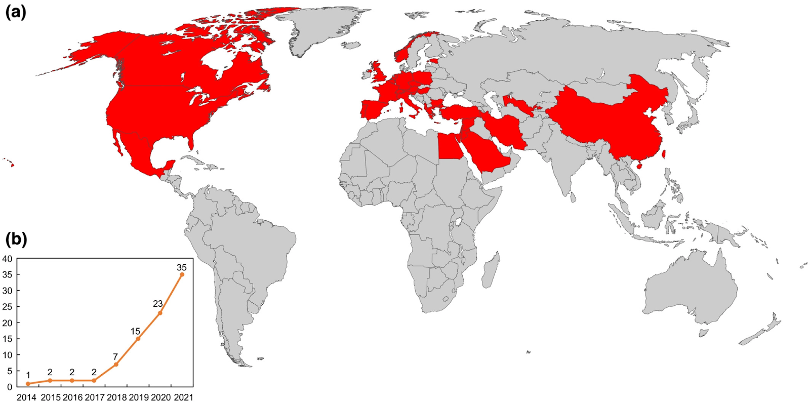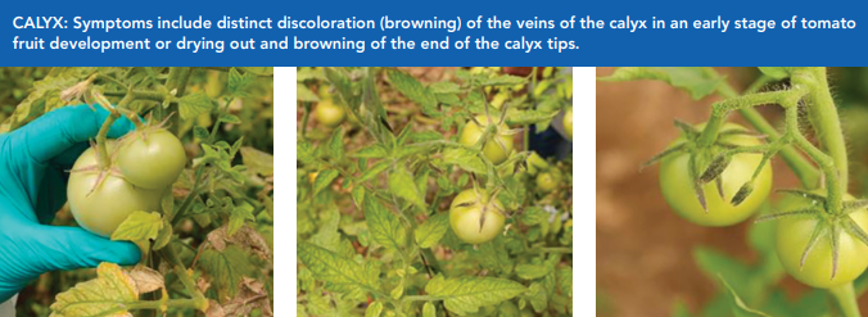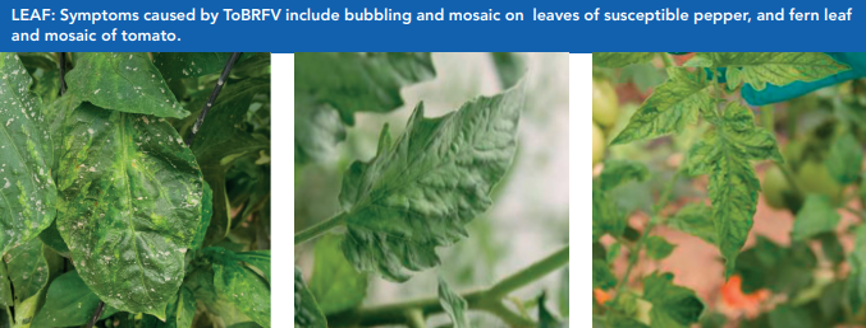
Pest: Tomato Brown Rugose Fruit Virus (ToBRFV)
Disease identification: Tomato brown rugose fruit virus, otherwise referred to as ToBRFV, is a highly virulent and aggressive plant virus that can cause serious infections on tomato and pepper species. ToBRFV behaves very similarly to other tobamoviruses such as ToMV (tomato mosaic virus) and TMV (tobacco mosaic virus). However, its main distinction from other tobamoviruses is its ability to overcome genetic resistance in tomatoes and cause severe fruit symptoms in otherwise genetically resistant varieties of tomatoes.
History: Tomato brown rugose fruit virus was first identified in 2015 on tomatoes grown in Jordan, where it was then traced back to its first occurrence in Israel in 2014. The virus has been confirmed in the United States, Mexico, Germany, Italy, Saudi Arabia, Israel, Jordan and Turkey. After the discovery of ToBRFV in Jordan and Israel, the virus spread rapidly due to the nature of seed production, the distribution chain, and ToBRFV’s seed transmissibility.

Image from: Zhang, S., Griffiths, J.S., Marchand, G., Bernards, M.A. and Wang, A. (2022)
Host plants:
Tomatoes and peppers are the only natural hosts of ToBRFV.
Most common damage symptoms:
Fruit: Symptoms include blotching, pale color, necrotic brown spots, or otherwise totally aborted fruits.

Image from: American Seed Trade Association
Calyx: Vein browning and drying out.

Image from: American Seed Trade Association
Leaves: Symptoms include distortion of the leaf blade, wrinkling and bubbling, mosaic, shoestring (long narrow leaf blades) and fern leaf (small leaflets). In young tomato seedlings, symptoms include mild to severe mosaic on leaves with dark green bulges, narrowness and deformation. In young pepper seedlings, symptoms include stunted growth and small yellow to brown rugose dots (having a rough, ridged or wrinkled surface) followed by necrotic blotches on fruits.

Image from: American Seed Trade Association
Note: The symptoms of this virus can vary by the variety of tomato or pepper infected with ToBRFV and in some cases infected plants may be asymptomatic.
Management options:
Known resistance genes for other types of tobamoviruses will not protect plants against ToBRFV. Instead, preventative crop management and exceptional sanitation practices are the only known measures of preventing and mitigating the spread of ToBRFV. It is important to note that the virus is very stable and survives for long periods of time in infected debris, soil, or other contaminated surfaces.
In tomatoes and peppers, mechanical transmission of the virus occurs very easily — touching and manipulation of infected plants can easily spread the virus to otherwise healthy plants. The virus is also known to spread via infected fruit, root-to-root contact, and seeds. It has been found that tomato seeds extracted from ToBRFV-infected fruits are 100% contaminated and can transmit the virus.
Preventative measures of healthy crops:
- Only enter the crop or greenhouses with clean clothes/shoes.
- Use protective clothing that will stay in the greenhouse after use.
- Follow good hygiene routines such as washing hands with soap/disinfectants before and after handling plants.
- Sanitize all tools that come into contact with plants by using 10% bleach solution.
- Thoroughly clean and disinfect any surface areas at the end of every growing season.
- Get transplants or seeds tested by diagnostic labs for the presence of infected stock.
Measures to reduce spread from infected crops:
- Carefully remove symptomatic plant tissue and destroy it via burning/incineration in a manner to avoid airborne transmission. Do not lay infected plant material out in fields and do not compost.
- Quarantine the greenhouse of infected stock and always use protective equipment (disposable coverall and gloves) when handling any suspected or confirmed to be infected plants.
- Wash all clothes in hot water and soap before using them again.
- Avoid moving from infected greenhouses to uninfected houses/fields.
- At the end of cultivation make sure all materials, tools and the greenhouse are cleaned and disinfected thoroughly.
- Fields where confirmed infected crops have been grown should be removed from tomato and pepper growing for the foreseeable future — it is not yet known how long this virus can remain infective in a field environment, but it is expected to be a long time.
Sources
Written by Dr. Alicyn Smart, Associate Extension Professor and Ruby Bonilla
Goldy, Ronald. “Tomato brown rugose fruit virus (ToBRFV): A new concern for tomato and pepper producers,” Michigan State University, November 25, 2019, https://www.canr.msu.edu/news/tobrfv-a-new-concern-for-tomato-and-pepper-producers
“Q&A ON THE NEW TOBAMOVIRUS: TOMATO BROWN RUGOSE FRUIT VIRUS (ToBRFV),” American Seed Trade Association, (n.d.) https://www.betterseed.org/wp-content/uploads/ToBRFV-QA.pdf
Zhang, Shaokang, Jonathan S. Griffiths, Genevieve Marchand, Mark A. Bernards, and Aiming Wang. “Tomato brown rugose fruit virus: An emerging and rapidly spreading plant RNA virus that threatens tomato production worldwide.” Molecular Plant Pathology, 23 (May 2022): 1262–1277. https://doi.org/10.1111/mpp.13229
Chanda, Bidasha, Md Shamimuzzaman, Andrea Gilliard, and Kai-Shu Ling.“Effectiveness of disinfectants against the spread of tobamoviruses: Tomato brown rugose fruit virus and Cucumber green mottle mosaic virus.” Virol J 18 (2021): 7. https://doi.org/10.1186/s12985-020-01479-8
